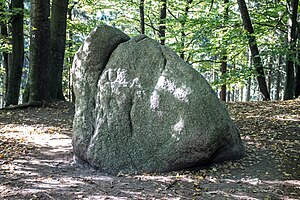Karlstein (rose garden)
|
Natural monument foundling Karlstein
|
||
|
Karlstein near Schwiederstorf (east side) |
||
| location | Neu Wulmstorf , Harburg District , Lower Saxony , Germany | |
| Identifier | ND-WL 11 | |
| Geographical location | 53 ° 24 ' N , 9 ° 50' E | |
|
|
||
| Setup date | November 3, 1936 | |
| administration | Harburg district | |
The Karlstein is a granite boulder from the Ice Age , which is located in the Schwiederstorf district of the Neu Wulmstorf community in the Rosengarten state forest (see the neighboring community of Rosengarten ) north of the Rosengartenstrasse in the Harburg district in Lower Saxony . It is located in the Harburg Mountains about 1.75 km west of the Rosengarten Forestry Office on a narrow, wooded hill above a steep ridge. The name comes from a legend that connects the stone with the Frankish king Charlemagne .
description
The stone with the dimensions 1.9 × 2.5 × 2.2 m is a medium-sized reddish-gray boulder. It piqued interest early because of its size, deep gullies, and chiseled horseshoes . There are stones with horseshoe marks in different places. The next stone of this kind was in Regesbostel in the Harburg district. Other stones are the Bickelstein near Wittingen (also in Lower Saxony) and the Roßtrappe in the eastern Harz .
A few meters away next to the Karlstein is a stone made of the same material, which is a blast.
There are various theories about Karlstein. Accordingly, like other horseshoe stones , it has a meaning as a boundary stone , place of execution or place of worship . In 1951 the area around the Karlstein was scientifically examined. It turned out that the stone is in its original geological position. It comes from southern Sweden and was transported by the glacier masses of the Ice Age and remained in its current place after they melted about 10,000 years ago. The deep grooves on its back are natural, weathered secretion joints in the rock. The horseshoes and the other carvings are due to human activity.
The stone already had a meaning for the people in the Neolithic Age . A flat ax and two flint tools were found on him . Based on the find situation it can be assumed that they were deliberately deposited there. The time of the carving and its significance is not known.
The Karlstein is part of the Schwiederstorf coat of arms and natural monument "ND WL 00011" in the Harburg district .
legend
A legend , with several variants, connects the stone with the Frankish king Charlemagne: He laid down on the stone during the Saxon wars , but before that he was forbidden to wake him on the penalty of death. While he slept, enemy Saxons approached. Since none of Karl's entourage wanted to be in danger, the ruler's dog was thrown at the sleeping man. He woke up and saw the impending danger and shouted: "As sure as I will split this stone with my sword, so certainly we will defeat the Saxons." Jumped on his steed, which passed over the stone, and split the stone with one blow. He defeated the Saxons. The red color of the town stone when it is gray is said to come from earth soaked with their blood. After the victory he is said to have set up camp at Langenrehm . Today the horse's shoes and the dog's paws in the stone are supposed to remind of the incident.
literature
- Hery A. Lauer: Archaeological walks in northern Lower Saxony. A guide to sights of prehistory and early history. Volume II, Angerstein: Verlag H. Lauer, 1979, p. 127
See also
Web links
Individual evidence
- ↑ Information board at the rest area
- ^ Willi Wegewitz : work report of the Helms Museum for the time from l. April 1950 to March 31, 1954. In: Museum and Heimatverein Harburg Stadt und Land eV (Hrsg.): Harburger Jahrbuch . No. 5 , 1955, ISSN 0722-6055 , p. 176–179 ( PDF in the Hamburg State and University Library ).
- ^ Johann Georg Theodor Grasse: Book of sagas of the Prussian State 1–2 , Volume 2, Glogau 1868/71, pp. 998–999.




